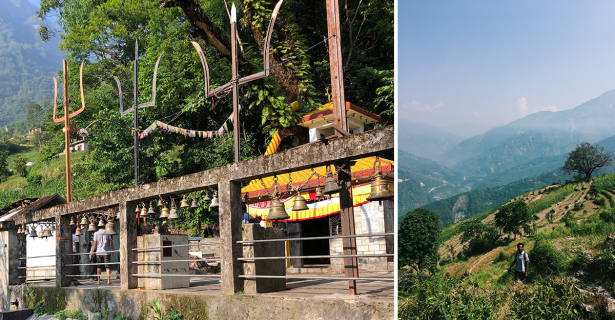We arrived at PHASE HQ loaded with all of our supplies for our nine day stay in Sindhupalchok district. The six of us, including the three public health students, crammed into a small Jeep and set off early in the morning. Eager to escape the commotion and air pollution of Kathmandu, we looked over the details of our survey trip, which was divided into two stays: Dhuskun and Chokati. As we drove farther away from Kathmandu Valley, the dense and noisy city gave way to lush green mountains patterned with terraced farms. The single lane road hugged the steep cliffs—we were careful not to look over the edge for too long and placed extra faith in our driver. After four hours of bumpy roads and sweaty quarters, we arrived at our first town: Dhuskun.
Walking past goats, cows, and rows of maize, we dropped our backpacks off on the front porch of a clay farmhouse with a tin roof. We were welcomed by PHASE’s local social mobilizer, Sushila, who would help us navigate the nearby village and connect us to the local beneficiaries. She spoke only a few words of English and her family greeted us warmly in Nepali. During our four day stay in Dhuskun, we woke up to the crows of roosters, drank sweet Nepali chai, and munched on homemade popcorn and fried soybeans. Twice a day, we ate a typical Nepali meal, which consisted of boiled rice, a lentil soup called Dhal, and a side of curried vegetables. We quickly learned to adapt to the sparse rural amenities which included an outdoor squat toilet, unreliable electricity, and a fifteen-minute walk uphill to the nearest flowing water source. Nearby neighbors and curious children stopped by to greet us; the public health students were invaluable resources in helping us exchange with these friendly faces.
During the day, we were assisting with PHASE’s endline impact survey—the purpose of which was to assess the success of various livelihood and health interventions. All eighty-nine of Dhuskun’s survey participants were PHASE’s beneficiaries. Sushila, our mobilizer, would bring us from household to household, and during each thirty- minute interview, we would collect data regarding the beneficiary’s agricultural productivity, perceived health status, and satisfaction with PHASE’s programs. In order to accommodate the agrarian work schedules of the beneficiaries, we conducted our surveys early in the morning and late in the afternoon. Sample questions include: where do you usually visit for health services and checkups? (Government Health facility, Faith Healer, Ayurveda facilities...) What changes in your family’s food habits, livestock, technical knowledge, and health have you experienced recently, specifically after PHASE’s program?
In one of the many stories we heard, a villager in Dhuskun revealed that his quality of life has greatly increased after the government implemented road systems and electricity in recent years.
We also conducted a survey to assess the preparedness of two local government health outposts. The survey specifically examined the medical equipment, medications, and level of training of health practitioners available to Dhuskun’s population. The typical health outpost is staffed by six professionals: a chief health worker, two auxiliary midwives, two community medical assistants, and one office assistant. While there, we were able to witness a uterine cancer screening and prevention seminar. According to the public health students, around two in five women in the area are affected by uterine cancer. In addition, the outpost was holding Tuberculosis screenings.
After five days of data collection, we were ready to move to our next location, Chokati. Sushila recommended that we use the bus as transportation; it was new to the region as roads were built within the last two years as part of government infrastructure development. Backpacks strapped on, we waited patiently for the 9 AM arrival only to be met by a bus so overcrowded that twenty or so villagers were sitting on top of the bus. There was even a distressed goat crammed in between containers of gasoline and crying babies. It didn’t take long for all us to decide to brave the four-hour hike with our heavy backpacks instead of risking the mountainous bus drive. Although physically exhausting, the hike gave us beautiful views of the green valleys and the Himalayan mountains in the distance.
We were welcomed by a new host family in Chokati—a village even more remote and rural than Dhuskun. During this homestay, we stayed in a cement block, two-story home still under construction. Beehives encircle the house and slightly below the home is a mushroom farm and buffalo pen. Again, we were met by a young woman who would be our social mobilizer—further showing PHASE’s commitment to empowering the local women and exposing them to opportunities they may not have had in the past. Although four hours away, life appears almost identical to Dhuskun, whether it is the food we eat or the friendliness of the locals. We continued surveying eighty-one new households and one day even had the opportunity to visit a local Shiva temple. As we observed the dietary restrictions, daily rituals, and commonplace shrines and symbols, it became clear Hinduism is an integral part of Nepali day to day life.
We have a few more households to interview, after which, we are returning to Kathmandu to analyze the data we have collected and compose a comprehensive report useful to PHASE.

